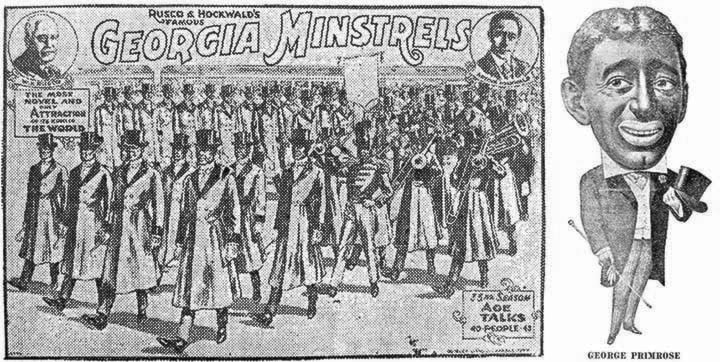Jim Cameron
"I knew a man Bojangles and he'd dance for you..."/Jerry Jeff Walker
Consider the following black racist stereotypes:
"Mammy" — wise, self-sufficient, full-figured and wearing a bandana;
"Zip Coon" — leaning towards arrogance and flamboyancy and full of puns, malapropisms and a general misunderstanding of the English language;
"Uncle Tom" — white-haired, kind, gentle and religious;
"Buck" — large, loud and proud with an eye for women;
"Pickaninny" — young with bulging eyes, unkempt hair, poorly dressed and a love of watermelon;
"Jezebel Wench" — a temptress, typically portrayed by a male in female garb;
"Mr. Tambo and Mr. Bones" — dancing, joyous musicians.
Do any of the above sound familiar? If so, welcome to the Minstrel Shows of yore and the characters to which they gave rise, doubtless playing a large and unfortunate role in the white vision of black America, a very bigoted vision that, for decades, comprised one of the most popular professional and amateur entertainments in North America.
Long after its on-stage partner vaudeville had disappeared, community groups relied on an evening of blackface entertainment to attract crowds.
Cranbrook was no exception. The combination of music, humour and dance continued to work its questionable magic from the earliest days well into the 1960s. Although the professional traveling minstrel show was effectively finished by the First World, the burnt-cork blackened face and exaggerated white lips lived on in communities until the Civil Rights movement of the 1960s managed to shut things down, more or less..
The minstrel show itself generally consisted of three acts: The first, in which the entire troupe danced onstage, sang and traded wise-cracks; the second, a series of variety acts highlighting the skills of the individual performers; and the third, a slapstick musical production involving a plantation or a parody of a well-known play. Not too far removed from what we now refer to as an evening of television.
The first authentic minstrel show to hit Cranbrook was Willis' Coontown 400 — "The Premier Colored Organization of America in a Rag Time Operatic Burlesque" — in February, 1900. They travelled by rail, as was common, and played for two large crowds in the Forrest Opera House (later the Wentworth Opera House/Edison Theatre and now the Baker Street-10th Avenue intersection). The local paper reported it as "a most creditable performance ... clean from beginning to end." As opposed, say, to the McKanlass Minstrel Show that came through the following year and gave an after-show (a performance following the main performance for men only) that "was a disgrace to any civilized community ... the outfit should be run out of any town where they put up such a sensual and demoralizing entertainment. The jokes were rank, the references were vile and the entire program of that part seemed to be arranged for the purpose of catering to the lowest order of mankind." It was likely well-attended.
Within a month a local group performed Cranbrook's first amateur minstrel show to raise funds for the fire brigade, a show that was decidedly on the "clean" side, played to a packed house and hit the road for a show at Fort Steele.
Although minstrel shows before the American Civil War consisted primarily of white performers (sometimes black performers imitating white performers imitating black performers) by the late 1860s the professional touring shows were almost exclusively black performers in blackface. Many companies incorporated the term "Georgia Minstrels" as with Richards and Pringles big production in August, 1901. The show featured fifty popular colored minstrel and vaudeville entertainers, the cleverest "end men" [sitting at the end of the line and engaging the interlocutor/announcer in banter]; the Alabama quartet; a novelty act entitled "The Black Watch Drill"; Shields, the king of aerialists and the "Realm of the Mikado" with the entire company in Japanese costumes. A street parade included imported English dog carts drawn by Kentucky thoroughbred horses and two brass bands. How was the show? No way to tell. There was no mention of the actual event. Nonetheless, it gives an idea of the breadth of the general entertainment involved. Richards & Pringle shows definitely did, in fact, perform in Cranbrook a number of times over the next ten years, as did many others.
The shows expanded as the years went by: big street parades, orchestras, open air concerts, modern melodies, electric surprises, gorgeous costumes, dancing contests, ten members, twenty members, fifty members, all the original thing and each one "better than the rest"; Alabama blossoms, Ethiopian queens, southern suffragettes, minstrel kings, anything and everything that spoke of the old south and all that it entailed.
There were, of course, some truly brilliant entertainers amongst the many who plied their trade in Cranbrook, perhaps none more so than the legendary George Primrose, often credited with inventing the soft-shoe, who brought his travelling show into town in May, 1915. What was once low-comedy and African-American song and dance was now highly refined with only the end men and Mr. Primrose himself in black face, "Rusco and Hockwald's Famous Georgia Minstrels — Forty People, Band and Orchestra — The most novel and only attraction of its kind in the world", played the old auditorium on 10th Avenue in January, 1924, the last of the professional minstrel shows to appear in the city.
Cranbrook has seen its fair share of performers over the century, most of them long gone with little trace. There are, however, some who have risen to great fame and glory. One in particular is certainly worth a mention, a man who literally changed the face of Hollywood movies. In fact, according to his publicity he changed it one-thousand times. It is most fitting that he make an appearance next week to honour All Hallow's Eve.
